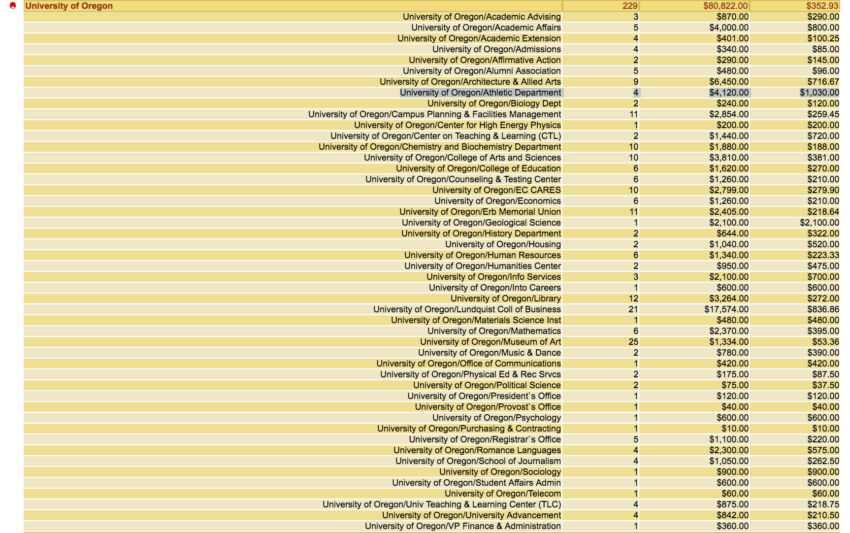Great news – just as President Gottfredson promised the Senate he’d try and do! This will certainly help reduce the expected tuition increases! Just kidding, this news is from the University of Wisconsin athletic department. And of course there’s some funny accounting anyway – story here. But still, it’s progress. How did it…
Posts tagged as “athletics subsidy”
Just kidding, coach wants that $1.7M. UO is planning to raise student fees to pay for the new health center and keep the ticket subsidy for athletics. Diane Dietz has the story here.
11/29/2016 update: The RG’s Ryan Thornburn has the shocking details here.
Or at least I think it was the basketball coach – he’s about to drop out of the rankings too. But maybe his buyout is next year.
Meanwhile, Mullens, Altman, Helfrich and the other well-paid Athletic Department employees haven’t been giving much to the University’s Charitable Fund Drive for state and community charities:

11/28/2016 update: Matt Helfrich wins excellent $9.4M buyout with lousy 34-44 Civil War loss
10/30/2016: First it was the survey revealing that students cared more about UO’s Urban Farm Program than big-time college sports. Now, according to sports reporter Kenny Jacoby in the Daily Emerald and his report on the brief student turnout for the Arizona State game, the list of things our students prefer to watching the Ducks has grown to include a nap, Halloween, and yes, homework:
Oregon was winning 30-22 when masses of students started heading for the exits. I was curious why they chose this point in the game to leave, with the Ducks on the verge of their first win since Sept. 10. So I went down to the concourse level, stood at the top of the stairs above the South Gate and asked departing students why they were leaving. Here are some of their responses:
“I’m really, really high, and I want to lie down,” the first student said.
“It’s Halloween weekend,” said another.
“We’re tired from last night. We’re trying to nap and recover before going out to tonight. I just turned 21.”
“We’re tired. I have homework to do.”
Which does raise the question of why the ASUO is paying Rob Mullens, Eric Roedl and the Duck sports enterprise $1.7M for “free” tickets. More on that here.
9/15/2015: UO’s urban farm brings in more students than Duck athletics
And, according to the NYT, it’s part of a movement. UO’s Landscape Architecture department is now running two sections, just a few slots left:
Not bad compared to student attendance at Dana Altman’s basketball games.
2/27/14: UO students say “sorry Ducks, we’re just not that into you.”
Elevator version: Moffitt says the academic budget is sort of OK. Meanwhile Mullens is raking in the dough, and spending it just as quickly on whatever he wants. No talk of the long overdue Athletics Department contributions to UO’s academic mission. Finance and Facilities Committee — September 8, 2016 10:00 am…
And so it begins. Andrew Greif has the story in the Oregonian here. The complaint to the federal court is here:
Here’s a bit from Athletic Department Director Rob Mullen’s July 2012 planning document, full pdf here. Price elasticity is the top threat to Duck Athletics, followed by the NCAA, and Professors Harbaugh and Tublitz: RG sports reporter Steve Mims reported on the elasticity threat w.r.s.t. Dana Altman’s basketball team back in March, here:…
The Chronicle of Higher Ed has the good news here: Part of that money has gone to support the operations of the [Library]. It has also been used to establish faculty chairs in various colleges and to pay for art acquisitions and construction costs of an arts building. The athletic department…
While AD Rob Mullens and Duck apologists like VP for Enrollment Roger Thompson love to talk about the benefits of the Duck’s big-time sports enterprise, there are a few costs as well. Former UO economics professor Jason Lindo (now at Texas A&M) and coauthors (including Isaac Swensen a UO PhD grad)…
Columnist Sally Jenkins, here: … For years, athletic directors have styled themselves as CEO-types and moaned about the difficulties of managing costs. But a Washington Post project published earlier this week shows that these so-called executives are about as fiscally responsible as Gabor sisters serving sevruga in chinchilla capes. The truth…
You can’t make this shit up: The cost of this bloated project has gone from $8M to $16M. While the donor has apparently paid for all the construction, this is UO land that will now be off limits for academic use for a long, long time. At a very rough guess,…
Nike’s no bid contract with UO is pretty stingy (except of course for the annual $30K clothing allowance for JH insiders). The Eugene public schools drive a tougher bargain. Alisha Roemeling in the RG: Apparel giants Nike and adidas have found a new arena in which to compete: for the…
but just this Thursday at 1:00, for a meeting of the Senate’s Intercollegiate Athletics Committee: Word is that SSA Director Steve Stolp and his boss Lorraine Davis will address questions about the effectiveness of the Services for Student Athletes operation, which segregates Duck athletes from regular UO students while making the regular…
11/16/2015: Full docket here, full opinion here. I have no idea what it means, except that UO’s lawyers at Harrang, Long, Gary and Rudnick are going to get many more billable hours out of us before this ends: 2/17/2015: UO sues over Chip Kelly’s bonus insurance policy The bonuses Rob Mullens and Dana Altman…
No, this isn’t from the Duck Athletic Fund’s website, it’s from giving.uoregon.edu, the homepage of the UO campaign, which is supposed to be about the academic side of the fund-drive: To be fair, the other 4 landing pages are about academics. I guess 1 out of 5 ain’t bad. If you follow the…
